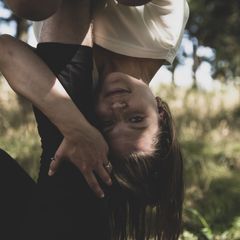THE USE OF CINEMATOGRAPHIC TECHNIQUES
I have worked a lot with film makers (Belinda Ackermann, Film Creatives, Katja Verheul and Lucie Sheppard) in the past five years, and have developed a keen interest in applying cinematographic techniques (close-ups to detail/ following specific movement and body parts/still frames with fleeting movement going and returning etc.) to live performance.
I have also felt an urge to subvert the way I am seeing stage performances where we as audiences are directed to specific performers or events on stage with lighting and staging. And so, I started paying close attention to dancers furthest upstage, trying to follow just certain body parts, to see through one eye etc. All methods to direct my own viewing experience as completely different from what may have been intended by the choreographer/director.
THE SUBVERTION AUDIENCE EXPERIENCE
The ideas for this work sprung out of that desire to see dance differently, in a more physically engaged way. I have an interest in offering audiences an experience of dance in a way that is responsive to the movement taking place, and where there is also a reciprocal connection between what I as the performer, and the audience members, are doing kinetically. Almost making audiences co-creators of the work, but in a subtle, non-invasive way.
I am interested in making a piece of work which will work as both 60 mins performance and durationally, where audiences have the chance to enter and exit according to their curiosities.
It is important for me though that audience members aren’t drawn into the performance area, as I am not investigating this kind of completely participatory work. Instead audiences have a direct role in how the performance pans out, but without invading their expectations of their roles in the work.
I have recently become really interested in the act of inverting, potentially on the back of my thesis about the act of falling in aerial circus – but in a wider societal context.
This led me to an interest in spatial awareness and orientation for me as a performer and audience members alike.
For my London-performances of work in progress 2019-2020, I have given audience members options to view the piece inverted by laying in a hammock. I am also interested in what happens to the cognitive processes of viewing dance, when the blood is rushing to the brain instead of down, as when seated.
I am creating scores, which are audience responsive, building on some of my work with Inter Pares Project.
In short and simplified terms; I glean audience movements, gestures, weight distribution etc., to re-create into more expansive choreographic gestures.
There is a process of simply adding more and more of these gleaned movements, until I have gleaned from every audience member.
These movements then become instantaneous sequences, and audiences witness this process of live accumulation of just-gathered movement. These sequences can then be repeated, sped up and explored in choreographic methods, according to the scores I set up – responding to audience behaviour and playful willingness to participate.
The final aspect I want to explain is the site-responsive and semi-sustainable aspect of the piece. As mentioned, I collect audience movements, positions, directions, gestures etc., which directly feed into the live progression of the performance.
I also collect physical material in each place I hold a residency and/or perform the work, which is added to the installation as ocular devices, filters, frames etc.
The foundation structure, which I am developing in partnership with a designer, is one which can be collapsed and re-erected, and with spaces to add collected, recycled and re-used material from each place we visit. The structure thus allows audiences to view dance from above, below, inverted, seated, standing, lying down, rotating, and through filters, holes etc., but most importantly with a kinaesthetic experience of relatability to what is seen in front of them.
Not only is the recycling of local material a way of being more resourceful and using material which is already there. It is also a way for me to invite in parts of the culture, heritage, community of where I am taking this work. A way to engage the local community more directly with the presentation of the work.
Lastly, I collect sounds with my audio recorder. Iranian Composer, Azita Mehdinejad, has composed the ground music for this work. But at each place I visit with this work, I spent some days collecting sounds of domestic activities there which feel specific to that place, and layer these rough, raw, unedited sounds, with the more classical, polished sounds of Azita’s compositions.
This creates a contrast I find hugely interesting and is another way of inviting in the locality of each place, making each performance specific to where it is being performed.

